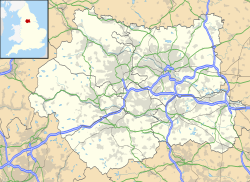| Oxenhope | |
|---|---|
 Oxenhope, West Yorkshire | |
Location within West Yorkshire | |
| Population | 2,626 (2011 census) [1] |
| OS grid reference | SE032351 |
| Civil parish |
|
| Metropolitan borough | |
| Metropolitan county | |
| Region | |
| Country | England |
| Sovereign state | United Kingdom |
| Post town | KEIGHLEY |
| Postcode district | BD22 |
| Dialling code | 01535 |
| Police | West Yorkshire |
| Fire | West Yorkshire |
| Ambulance | Yorkshire |
| UK Parliament | |
Oxenhope is a village and civil parish near Keighley in the metropolitan borough of Bradford, West Yorkshire, England. It was historically part of the West Riding of Yorkshire. The population was 2,476 at the time of the 2001 census [2] which had increased to 2,626 at the 2011 Census. [1] Oxenhope railway station is the terminus for the Keighley and Worth Valley Railway heritage railway.

